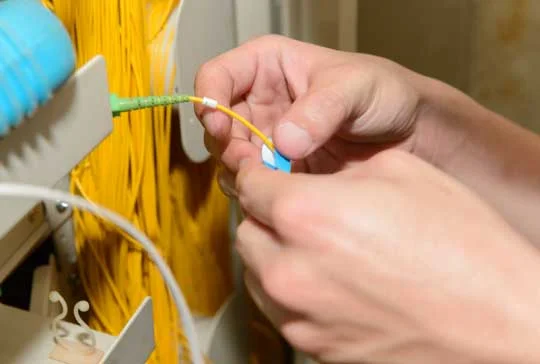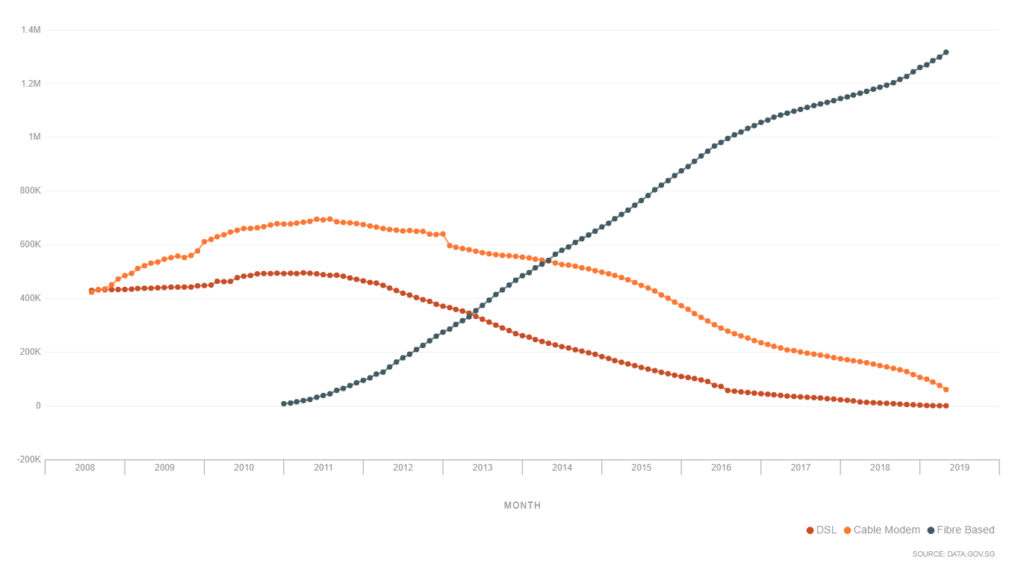Fibre Network
for Enterprises
Why do ENTERPRISES need Fibre?

Singapore’s Smart Nation initiative aims to digitise the entire economy and the global pandemic has greatly accelerated the digitalisation process among businesses, factories, government agencies, hospitals, schools, transport providers and etc.
Demand for online sales and digital solutions (for example, e-payment, e-invoicing, e-learning, telehealth, teleconferencing, cloud-based services, 5G, smart manufacturing, smart logistics, smart energy management, autonomous driving, Internet of Things (IoT) and etc.) is expected to surge as consumption patterns are altered and cost-competitive pressure mounts.
To fully digitalise the economy, there is a need for a robust and scalable fixed communication infrastructure that is capable of handling the ever-increasing amount of data affordably.
Benefits of Fibre
Fibre cables use light pulses to transmit data and they can transmit an almost infinite amount of data at scalable speed. They are also not susceptible to electromagnetic interferences and crosstalk issues.
Our coverage check portal is a free tool which allows you to check if your address is connected to the Next Generation Nationwide Broadband Network.

HOW TO GET FIBRE BROADBAND FOR ENTERPRISES?
NetLink Trust designs, builds, owns and operates the passive fibre network infrastructure of Singapore’s Nationwide Broadband Network (NBN). We provide an open, wholesale access of our fibre network to telecommunications operators, who then sell fibre broadband plans to you.
In this way, telecommunications operators can focus on offering innovative products and services to consumers without incurring high fixed costs.
WHAT IS THE INSTALLATION PROCESS?
You can find out more about the installation process here.

DATA CENTRES

The explosive growth of internet traffic has led to the proliferation of mission-critical data centres worldwide. As the digital landscape evolves, data centres have to constantly keep up with the ever increasing connectivity and the bandwidth demands. Fibre is the only network infrastructure that can transmit close to infinite amount of data at scalable speeds, making it ideal for data centre connections. NetLink provides fibre connections for data centres under the enterprise services customised agreement or tariff. With our most extensive nationwide fibre coverage in Singapore, you can be assured of quick and seamless deployment.
Case Studies and Opinion Pieces
Role of Fibre in 5G Network
We are transitioning into an intelligent world where real-time connectivity is unleashing greater efficiency through big data driven automation. A plethora of connected objects collecting, sharing and analysing data automatically in real-time brings a number of benefits:
- Save resource and reduce wastage
- Reduce manpower cost through the automation of repetitive, time consuming tasks
- Minimise downtime through active predictive monitoring
- Track the location of vehicles, equipment and products
- Improve the quality of life
Despite the wireless nature of 5G, its deployment is heavily reliant on the availability of fibre optics to transport the vast amount of data from the mobile base stations to the physical core network. Fibre is irreplaceable in 5G mobile backhaul as it is the only medium that can transmit an infinite amount of data at scalable speeds. In 100% fibre networks, the data transmission speed is only limited by the transmitters and receivers at each end. GSMA estimates that 5G will cover one-third of the world’s population2 by 2025, thereby intensifying the demand for fibre globally.
How 5G Shapes Fibre Deployment
5G uses millimetre waves to carry larger amount of data at much faster rate than 4G. A lot of base stations and antennas are required to ensure good 5G coverage as shorter wavelength means shorter range, making it difficult to penetrate objects like walls, buildings, trees, etc. Another key characteristic of 5G is network virtualisation – using software to manage both hardware and software resources to achieve greater efficiency and enable better customer experience.
However, more base stations and antennas will invariably lead to more interconnected paths, making the fibre network more complex. Even in Singapore where the nationwide fibre network is already extensive, new fibre cables still have to be laid to ensure efficient route planning to reduce cost, overcome distance and signal loss in 5G deployment. Based on our experience in the 5G Smart Estate Trial @ Singapore Science Park and the Singapore Maritime Drone Estate, fibre densification is about 2 times more than 4G.
The first use-cases in Southeast Asia to develop intelligent mobility solutions in a commercial space, 5G Smart Estate Trial is a key initiative of the Smart Urban Co-Innovation Lab aimed at developing, testing, and deploying sustainable smart city products and services, such as better 5G network coverage or autonomous vehicles.
The Singapore Maritime Drone Estate provides a conducive space to test bed and develop transformational drone technologies for maritime applications, such as shore-to-ship deliveries and remote inspections of ship and container cranes. Innovative applications of drone technologies can bring benefits, such as increased productivity, reduced need for manpower and lower costs.
The planning of fibre deployment is an important, but often overlooked part of the entire process. While many assume that fibre losses are low in general, careful planning is required to design the fibre network so that it meets critical parameters such as latency, distance and losses, particularly in crucial applications like 5G and advanced technologies like Quantum Computing. The extensive fibre network in Singapore is being continually improved and refined to ensure that direct connections are being implemented with the latest fibre cores to meet future technological challenges. It will remain a cornerstone in providing a steady and resilient platform for Singapore to advance its digital ambitions.
Need to Accelerate 5G Deployment
As seen from the above, nationwide fibre coverage is a requisite for 5G deployment. Laying fibre cables to the premises (FTTP) will incur high fixed costs, even in a highly urbanised environment like Singapore.
Governments across the world have taken different approaches to fibre deployment. For example, private telecommunication operators like NTT and Verizon provide majority of the fibre infrastructure in Japan and the United States. In some countries, fibre networks are being deployed by utility companies (e.g. Open Fiber and M-Net) and online service providers (e.g. Facebook and Google).
At the other end of the spectrum, governments in Australia, New Zealand and Singapore have decided on the use of publicly funded national broadband network deployments (i.e. National Broadband Network (NBN), Ultra-Fast Broadband Network and Next Generation Nationwide Broadband Network (Next Gen NBN) respectively) to accelerate the pace of implementation.
The Next Gen NBN provides telecommunication operators in Singapore with a non-discriminatory, open and wholesale access to the nationwide fibre network, thereby allowing them to focus on offering innovative products and services to consumers and businesses without incurring high fixed costs. Singapore has achieved relatively good success via this mode of fibre deployment - it was the first country to offer 1 Gbps on a nationwide basis, with prices that are amongst the most affordable in the world – 1 Gbps below US$383.
It is important to note that technological advancements have significantly blurred the lines between the service offerings of telecommunication operators and tech companies. For example, Voice Over Internet Protocol (VOIP) technology and instant messaging service have significantly eroded the earnings of telecommunications operators. With digitalisation affecting all industries, telecommunications operators need to quickly evolve into digital players where differentiation is increasingly hinging on software and network virtualisation, rather than physical infrastructure. Apart from 5G deployment, telecommunication operators globally are venturing into areas like cybersecurity, data analytics, digital banking, digital advertising, Internet of Things (IoT), industry 4.0, etc.
Non-discriminatory, open and wholesale access to nationwide fibre network can significantly accelerate 5G deployment and allow telecommunications operators to focus on critical areas of innovation and software differentiation in the age of digitalisation.
1 Number of IoT connected devices worldwide 2019-2030 by Statista
2 5G Global Launches & Statistics
3 Innovative Business Models for Expanding Fiber-Optic Networks and Closing the Access Gaps by The World Bank Group (December 2018)Building the Fibre of a Smart Nation

3 https://www.speedtest.net/global-index
4 The Development of Fixed Broadband Networks by the Organisation Economic Co-operation and Development (Jan 2015)Fibre Deployment for Pokémon Go Safari Zone Event
For any gamer, on top of being equipped with the necessary tools, having a strong and steady connection adds to the whole gaming experience. Recognising the importance of having a stable connection, SDC spared no efforts in making the playing experience as seamless as possible.
Fibre Deployment
With an expected large turnout, SDC appointed M1 Limited (M1) as its internet service provider to enable a stable and seamless wireless connectivity throughout the event, with NetLink rolling out the backbone of the fibre network. As the nationwide operator for fibre network infrastructure, NetLink had the necessary resources, technical know-how and skillset to do this.
Four Non-Building Address Point (NBAP) connections were deployed by NetLink in Sentosa, to provide connectivity to wireless and mobile setup deployed by M1 for the event. This helped to support over a hundred outdoor access points broadcasting Wireless@SG, Wireless@SGx and private SSIDs for the players to connect to the Internet on their mobile devices when hunting for the Pokémons.
In spite of the short deployment timeline, NetLink worked closely with M1 who facilitated access with SDC and site surveys, to complete the set-up of the fibre connections in under 10 business days. The relentless support from all working partners was essential and of utmost importance in ensuring a smooth and successful deployment. This also helped in keeping the turnaround time short for deploying the connections.
“During the early planning stages of the Pokémon Go Safari Zone event, NetLink has been providing M1 with its fullest support. This has greatly smoothened the process in getting the fibre circuits up despite a tight project schedule. The provisioning teams from NetLink and M1 have shown great synergy, teamwork and communications, which contributed greatly to the speedy fulfilment of the required service.”
~ M1, Product Development and Corporate Solutions~
The Fibre Installation Experience
- Seamless
- Supportive
- Speedy fulfilment
- Experienced engineers and skilled contractors
- Equipped with technical know-how
INSTALLATION CHARGES AND PAYMENT
Method Of Provisioning | |||
|---|---|---|---|
Patch Cord handover at FTTB node of the Non-Residential Premises where NetLink Trust's Network ends | Installation of Termination Point inside the vertical telecom riser on the same floor where the Non-Residential Premises is located | Installation of Termination Point inside the Non-Residential Premises | |
Installation of Network Charge | SGD 52.32 | SGD 555.90 | SGD 625.66 |
Service Activation Charge | SGD 61.04 | SGD 61.04 | SGD 61.04 |
Relocation, Repair and Replacement and Removal Charge | SGD 52.32 | SGD 555.90 | SGD 625.66 |

